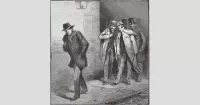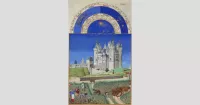Aaron Kosminski was a Polish immigrant residing in London during the late 19th century. Working as a barber and hairdresser, Kosminski unfortunately became a suspect in the infamous Jack the Ripper murders that terrorized Whitechapel in 1888. Despite circumstantial evidence linking him to the crimes, concrete proof of his guilt remained elusive, and the case against him was ultimately dropped. The mystery of Jack the Ripper's true identity continues to intrigue and baffle historians and criminologists to this day.
1901: Father's Likely Death
By 1901, it is believed that Aaron Kosminski's father had passed away. While the exact circumstances remain unclear, an 1887 death certificate suggests a possible link to an Abram Kosminski who died in Koło, Poland.
1910: Anderson's Claim
In his 1910 memoir, "The Lighter Side of My Official Life," Sir Robert Anderson, Assistant Commissioner of the London Metropolitan Police, alleged that Jack the Ripper was a "low-class Polish Jew."
February 1919: Deteriorating Health
By February 1919, Aaron Kosminski's health had severely deteriorated, with his weight plummeting to a mere 96 pounds (44 kg).
March 1919: Death
Aaron Kosminski passed away in March 1919 at the age of 53.
1919: Kosminski's Death
Aaron Kosminski died at the age of 53 in 1919 from gangrene in his leg while residing in a London mental hospital.
1919: Discrepancy in Swanson's Notes
Despite aligning with known facts about Aaron Kosminski's life, such as his time in the workhouse and subsequent transfer to Colney Hatch Asylum, Swanson's notes contained a glaring inaccuracy: the assertion that Kosminski died shortly after being admitted. In reality, Aaron Kosminski lived until 1919.
1959: Macnaghten's Memo Discovery
A 1959 discovery brought to light a memorandum written in 1894 by Sir Melville Macnaghten, Assistant Chief Constable of the London Metropolitan Police. The memo, found among the personal effects of Macnaghten's daughter, Lady Aberconway, by television journalist Dan Farson, named "Kosminski" (without a first name) as a suspect in the Jack the Ripper case.
1984: Jeffreys' Initial Comments on DNA Evidence
In 1984, Professor Alec Jeffreys, the inventor of DNA fingerprinting, called the findings connecting Kosminski to the Jack the Ripper case "an interesting but remarkable claim." He emphasized the need for peer review and detailed analysis of the evidence, including the shawl's origin and the DNA match's nature.
1987: Martin Fido's Theory on Aaron Davis Cohen
In 1987, Martin Fido proposed that Aaron Davis Cohen, another Polish Jew incarcerated at the same asylum as Kosminski, might be the real Jack the Ripper. Fido suggested that Cohen's name was a simplification of a more complex name like Kosminski or Kaminsky and linked him to "Leather Apron," a suspect from local rumors.
1987: Martin Fido's Research
In 1987, determined to uncover the truth about Jack the Ripper, author Martin Fido embarked on a search of asylum records for any individuals named Kosminski. His efforts led him to a single match: Aaron Kosminski.
2000: John Douglas's Profile of Jack the Ripper
In 2000, former FBI profiler John Douglas, in his book "The Cases That Haunt Us," suggested that behavioral evidence pointed to someone like David Cohen as Jack the Ripper, contrasting with Nigel Cawthorne's dismissal of Cohen as a suspect due to his erratic behavior.
2001: Edwards' Inspiration
Russell Edwards' quest to solve the Jack the Ripper case was ignited by the release of "From Hell," a 2001 film starring Johnny Depp that delved into the Whitechapel murders.
2006: Swanson's Notes
In 2006, a significant piece of the Jack the Ripper puzzle surfaced: a copy of Sir Robert Anderson's memoirs annotated with handwritten notes by Chief Inspector Donald Swanson, who had spearheaded the Ripper investigation. Swanson explicitly identified the suspect as "Kosminski," adding that he had been under police surveillance at his brother's Whitechapel residence.
2007: Criticisms and Defense of DNA Evidence
In 2007, Donald Rumbelow questioned the shawl's connection to Eddowes, while Peter Gill highlighted potential contamination issues. Critics pointed out that Eddowes's descendants had access to the shawl, casting doubt on the DNA evidence's reliability. Despite criticism, Louhelainen defended his work.
2007: Shawl Purchase
In 2007, Russell Edwards acquired a shawl purportedly discovered at one of the Jack the Ripper murder scenes. He subsequently submitted it to biochemist Jari Louhelainen for DNA analysis.
2013: SWGDAM Guidelines Highlighting DNA Discrepancies
The SWGDAM 2013 guidelines, referenced in the 2019 study, stated that two or more nucleotide differences between DNA samples could indicate different sources, except in cases of heteroplasmy. The study did not suggest the presence of heteroplasmy, further complicating the interpretation of the DNA findings.
September 2014: DNA Evidence Announced
In September 2014, Jari Louhelainen, a specialist in historical DNA analysis, made a groundbreaking announcement. Commissioned by author Russell Edwards to examine a shawl believed to have been found with Catherine Eddowes, one of Jack the Ripper's victims, Louhelainen claimed to have extracted mitochondrial DNA from the garment.
September 2014: Russell Edwards' Claim
In September 2014, author Russell Edwards published a book titled "Naming Jack the Ripper," in which he asserted to have proven Aaron Kosminski's guilt in the Jack the Ripper murders.
2014: Initial Criticism of Louhelainen's Findings
Louhelainen's 2014 findings faced criticism for lacking peer review from the scientific community, raising concerns about the validity and reliability of the results.
March 2019: Publication and Analysis of Mitochondrial DNA Study
In March 2019, a study published in the Journal of Forensic Sciences examined mitochondrial DNA from a shawl linked to Catherine Eddowes. While the study found matches between the shawl's DNA and the victim's and suspect's DNA, it also noted discrepancies that raised doubts about a definitive link.
2019: DNA Analysis Publication and Criticism
A peer-reviewed article detailing the DNA analysis conducted on the shawl was published in the Journal of Forensic Sciences in 2019. However, scientists from Innsbruck Medical University challenged the paper's findings and methodology, citing errors and questionable assumptions.
2019: BBC Documentary Supporting Kosminski as Suspect
In 2019, a BBC documentary titled "Jack the Ripper: The Case Reopened," presented by Emilia Fox, concluded that Kosminski was the most likely suspect in the Jack the Ripper case.
2022: Kosminski's Waxwork at Madame Tussauds
In 2022, a wax figure of Aaron Kosminski was included in the reopened Chamber of Horrors exhibition at Madame Tussauds, solidifying his image in popular culture as a key suspect in the Jack the Ripper murders.
Mentioned in this timeline

John Christopher Depp II known as Johnny Depp is an...

Books are a means of storing information as text or...
Poland officially the Republic of Poland is a Central European...

Jack the Ripper was an unidentified serial killer active in...

September is the ninth month of the year in the...
Trending

Jared Isaacman is an American billionaire entrepreneur known for founding Draken International a private air force provider and Shift Payments...
Susan Boyle is a Scottish singer who gained international recognition after her appearance on Britain's Got Talent in Her performance...
2 months ago ACA Subsidies Expiration Fuels Premium Fears Amid Government Shutdown, Impacting Covered California
1 month ago Gary Cole Reveals Original 'Brady Bunch' Cast Reaction to 1995 Movie.
2 months ago McDonald's Employee Shoots Customer After Argument Over Delayed Order in Florida.

13 days ago Report reveals FBI's internal paralysis; Patel and Bongino defend their tenures.
Popular

Candace Owens is an American conservative political commentator and author...

Ilhan Omar is an American politician currently serving as the...

XXXTentacion born Jahseh Dwayne Ricardo Onfroy was a controversial yet...

Frederick Christ Trump Sr - was an American real estate...

Bill Gates an American businessman and philanthropist revolutionized personal computing...

Charles James Charlie Kirk was a prominent American right-wing political...